Collection of materials relating to neuro-ophthalmology as part of the Neuro-Ophthalmology Virtual Education Library.
NOVEL: https://novel.utah.edu/
TO
- NOVEL224
| Title | Creator | Description | Subject | ||
|---|---|---|---|---|---|
| 51 |
 |
Financial Social Legal Implications of Genetic Testing | Jonathan Thomas; James Brian Davis | Genetic testing looks for mutations in DNA and can give insight into genetic diseases. Costs associated with genetic testing are the testing itself, as well as genetic counseling. Test results may lead to further considerations, which may impact finances. Genetic test results can have a social impac... | Financial; Genetic Information Nondiscrimination Act of 2008; Genetic Testing; Legal; Social |
| 52 |
 |
Glaucoma: Evaluation and Principles of Management | Anand Haran; Sean Gratton | This is a narrated powerpoint that reviews the basics of glaucoma. It covers Primary Open Angle Glaucoma and Angle Closure Glaucoma, and includes reviews of the pathophysiology, evaluation, and management | Angle Closure Glaucoma; Glaucoma; Primary Open Angle Glaucoma |
| 53 |
 |
Injury Prevention in the Visually Impaired | Jonathan Thomas; James Brian Davis; Amanda Dean Henderson | With an aging population in the US, the number of those with visual impairments is also rising. Visual impairments increase the risk of falls, injuries, and other deficiencies, but there are several potential strategies to prevent these injuries. Members of the healthcare team can help visually impa... | Fall; Injury Prevention; Low Vision Specialist; Visually Impaired |
| 54 |
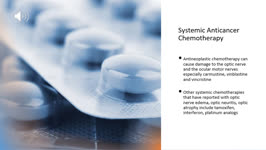 |
Neuro-Ophthalmic Complications of Chemotherapy | Nagham Al-Zubidi; May Ameri | This lecture covers the effect of antineoplastic chemotherapy, which can cause damage to the optic nerve and the ocular motor nerves. | Antineoplastic Chemotherapy; Ocular Motor Nerve Damage; Optic Atrophy; Optic Nerve Damage; Optic Nerve Edema; Optic Neuritis |
| 55 |
 |
Patient Portal: Pituitary Adenoma | Nagham Al-Zubidi, MD | The pituitary gland is a pea-sized gland that sits underneath the base of the brain. It produces and releases many hormones. These hormones control your metabolism, stress level, growth, ovulation and menstruation in women, sperm and testosterone production in men, milk production, and urine product... | Pituitary Adenoma; Pituitary Tumor |
| 56 |
 |
Ocular Lateropulsion Left AICA Stroke | Jorge C Kattah, MD | 82 year-old patient with basilar artery stenosis, she developed an acute left AICA stroke. On examination within 24 hours from symptom onset, she had primary gaze, unidirectional, right beat nystagmus and a positive left head impulse test. Brief periods of eyelid closure were associated with a h-... | Ocular Lateropulsion; AICA Stroke |
| 57 |
 |
Temporal Artery Biopsy Procedure | Nooran Badeeb; Danah Albreiki | Temporal artery biopsy is a procedure that is done in a patient with suspicion of GCA (Giant cell Arteritis), and some of the clinical manifestations that prompts us to suspect the diagnosis in patients older than 50 years old are: 1. GCA symptoms e.g. new onset headache. 2 . Visual symptoms: - Visi... | Temporal Artery Biopsy; GCA; Temporal Arteritis |
| 58 |
 |
Selective Saccadic Palsy After Cardiac Surgery | Nilan D. Schnure, MD; Ali G. Hamedani, MD, MHS; Grant T. Liu, MD | A unique gaze palsy selectively affecting saccades while sparing smooth pursuit, vergence, and vestibular reflex eye movements has been described following uncomplicated cardiac (and especially ascending aortic) surgery . This 69 year-old man reported persistent visual complaints immediately after a... | Saccade; Saccadic Palsy; Cardiac Surgery |
| 59 |
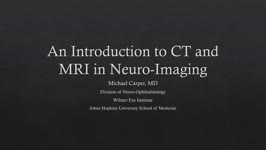 |
An Introduction to CT and MRI in Neuro-Imaging | Michael Carper, MD | A brief lecture covering basic neuro-imaging, including computed tomography (CT) and magnetic resonance imaging (MRI). | Computed Tomography (CT); Magnetic Resonance Imaging (MRI); Neuro-imaging |
| 60 |
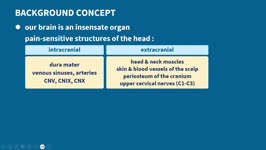 |
Headache Associated With Low or High Intracranial Pressure | Yu Hsin Chen; Amanda Dean Henderson; James Brian Davis | When intracranial pressure changes, the most common symptom is headache, which often has a positional component. We introduce various etiologies of headaches attributed to increased or low intracranial pressure, with idiopathic intracranial hypertension (or primary pseudotumor cerebri), post-dural p... | CSF Leak; Headache; Intracranial Hypertension; Intracranial Hypotension; Papilledema; Pseudotumor Cerebri |
| 61 |
 |
NANOS Illustrated Curriculum Section D Introduction | Meagan D. Seay, DO; Victoria S. Pelak, MD | Introduction video to the resources available in Section D of the NANOS Illustrated Curriculum. | Lesions, Afferent Visual Pathway; Disorders, Afferent Visual Pathway; Pupillary Anatomy; Disorders, Pupillary Function; Lesions, Efferent Visual Pathway; Ocular Motility; Abnormal Eye Movements; Eyelids; Abnormal Facial Movements |
| 62 |
 |
NANOS Illustrated Curriculum Section G Introduction | Meagan D. Seay, DO | Introduction video to the resources available in Section G of the NANOS Illustrated Curriculum. | Obesity, Management; Low Vision, Management; Genetic Diseases, Management; Patient Counseling |
| 63 |
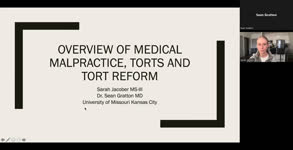 |
Overview of Medical Malpractice, Torts, and Tort Reform | Sarah Jacober; Sean Gratton | This is a brief narrated powerpoint, which serves as an introduction to the basics of medical malpractice. The definition and history of medical malpractice are explored. The relationship between medical malpractice and tort law are explained, and tort reform is introduced. | Lawsuit; Malpractice; Medical Malpractice; Medicolegal; Tort Reform; Torts |
| 64 |
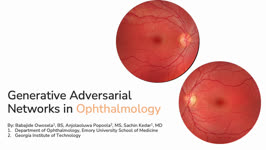 |
Generative Adversarial Networks in Ophthalmology | Babajide Olubusayo Owosela; Anjolaoluwa Popoola; Sachin Kedar | In this video we will describe Generative Adversarial Networks (GAN) models and its applications and limitations in Ophthalmology. GAN, a technique within machine learning, enables computers to utilize real data to generate valuable synthetic data, artificially produced information that mimics the s... | Artificial Intelligence; Generative Adversarial Networks; Machine Learning; Synthetic Data |
| 65 |
 |
Age Related Macular Degeneration | Riya H. Patel; James Brian Davis; Amanda Dean Henderson | Age-related macular degeneration (AMD) is a degenerative disease of the retina that causes central vision loss, and it is the leading cause of blindness in the developed world. Age is a strong nonmodifiable risk factor for AMD. Patients may have genetic susceptibility to AMD from mutations in genes ... | AMD; AREDS2; Exudative; Geographic Atrophy; Macular Degeneration; Nonexudative |
| 66 |
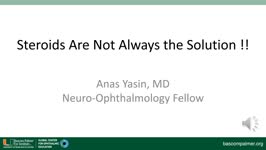 |
Steroids Are Not Always the Solution!! | Anas Yasin, MD | Leber Hereditary Optic Neuropathy (LHON) is the most common inherited mitochondrial disorder and typically affects young males. (https://eyewiki.aao.org/Leber_Hereditary_Optic_Neuropathy) | Leber Hereditary Optic Neuropathy (LHON) |
| 67 |
 |
Optic Tract Syndrome Secondary to Lacunar Infarction | Justin J. Grassmeyer, PhD; Kenan Xiao, MD; Jason T. Helvey, MD; Sachin Kedar, MD | Lesions of the optic tract produce a characteristic triad of clinical findings: contralateral homonymous hemianopia, contralateral relative afferent pupillary defect, and bilateral optic disc atrophy. This case describes clinical features, radiological findings, and optical imaging characteristics f... | Optic Tract Syndrome; Optic Tract; Lacunar Infarction; Homonymous Hemianopia |
| 68 |
 |
Practice Based Learning and Improvement (PBLI) | Karl C. Golnik, MD, MEd | Video describing methods and best practices of Practice Based Learning and Improvement (PBLI). | Practice Based Learning and Improvement (PBLI) |
| 69 |
 |
Maintenance of Certification Basics: American Board of Psychiatry and Neurology | Sean Gratton, MD | Video lecture covering certification basics. | Credentialing |
| 70 |
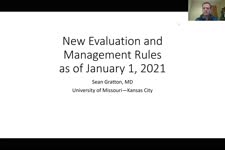 |
New Evaluation and Management Rules for 2021 | Sean Gratton, MD | Overview of the coding rule changes implemented on January 1, 2021. | Coding Rules |
| 71 |
 |
Crafting a Grant Proposal for Research | Silvia Sörensen, PhD | Lecture describing the process of writing a grant for research. | Grant Writing |
| 72 |
 |
Grant Pieces - Research Grants | Silvia Sörensen, PhD | Lecture describing the parts of a research grant, including using human subjects. | Grant Writing |
| 73 |
 |
My DEI Journey: Lessons Learned | Ore-ofe Adesina, MD | In this lecture, Dr. Adesina reviews his DEI journey in ophthalmology and the lessons of diversity, equity and inclusion he has learned along the way. He discusses why diversity, equity, and inclusion are all needed for a state of inclusive well-being, why representation matters for patient care and... | Ophthalmology; Diversity, Equity, Inclusion; Representation; Social Determinants of Health |
| 74 |
 |
Professionalism and Communication Skills | Karl C. Golnik, MD, MEd | Lecture covering professionalism and communication skills. | Professionalism; Communication Skills |
| 75 |
 |
A Brief Introduction to AI in Neuro-ophthalmology | Areeba Abid, BS; Sachin Kedar, MD | In this video, we describe the basics of artificial intelligence and machine learning as applicable to clinical neuro-ophthalmologists. We use the example from a recent publication, where AI software was used to detect optic disc edema in fundus images. | Artificial Intelligence; Machine Learning |
